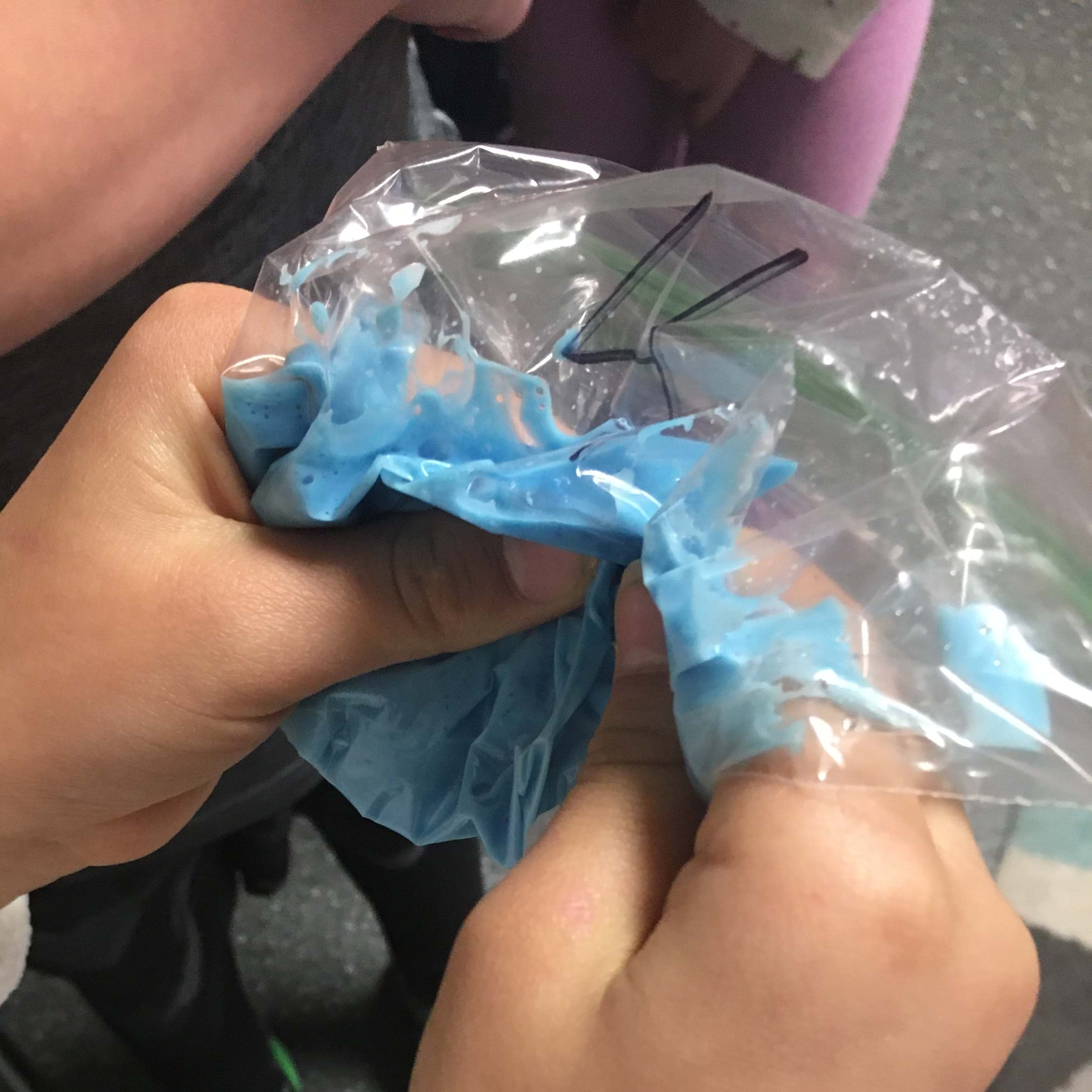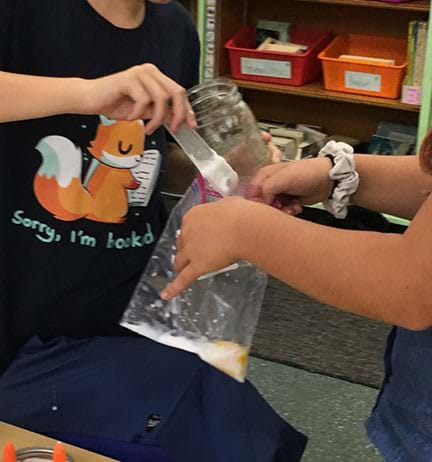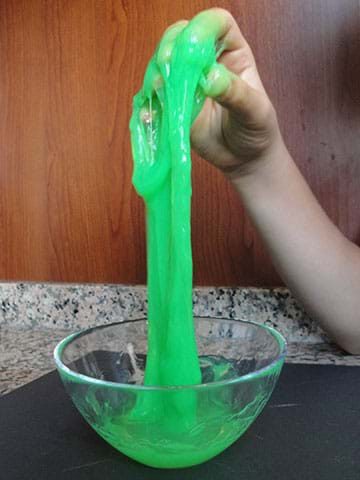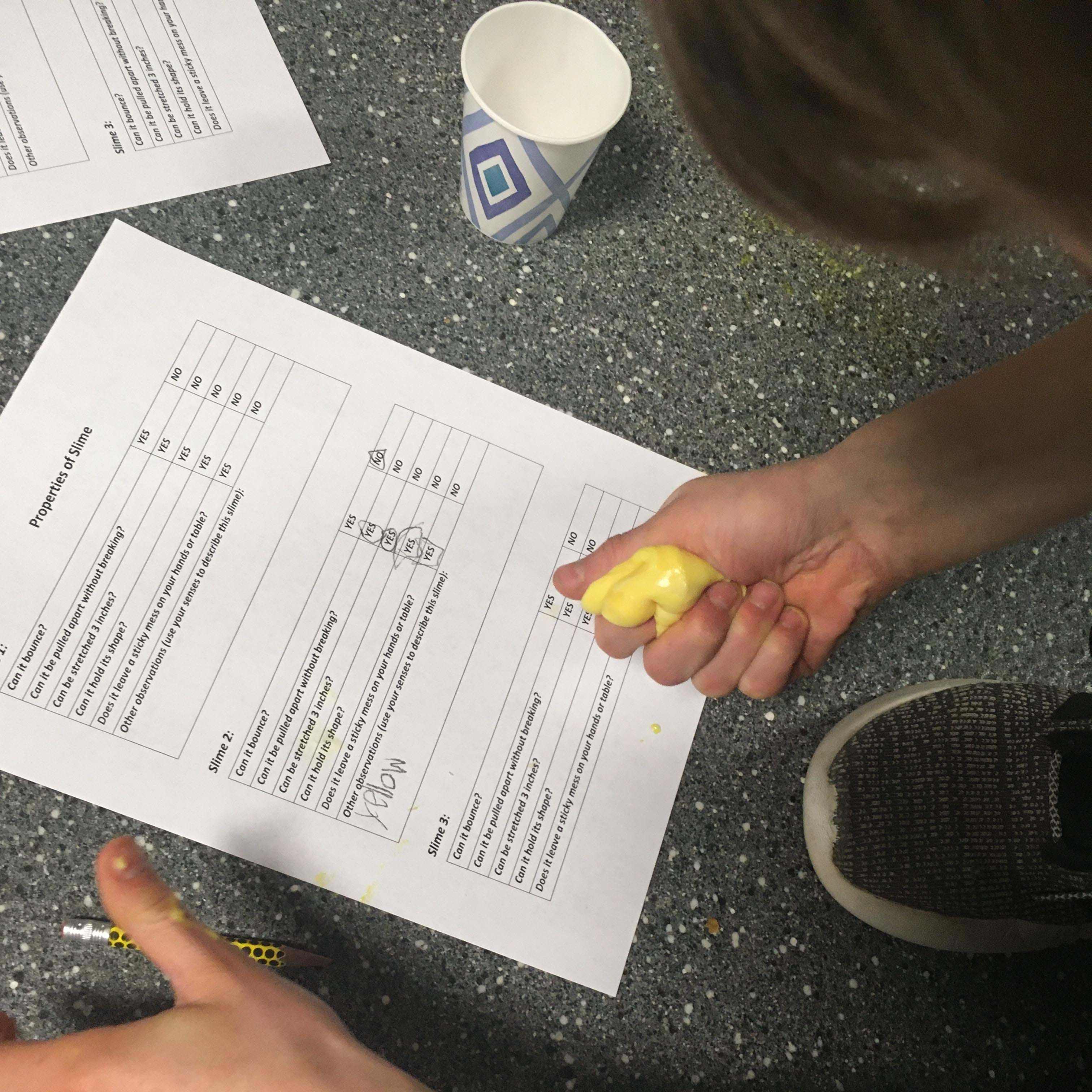Summary
An exploration of an engineering brief from a mock toy company leads students to explore a new slime with a unique set of characteristics. Using simple directions, students create five different types of slime and classify their slime properties against the criteria provided by the mock toy company. Based on their observations, they identify the best slime recipe based on the resulting physical properties.
Engineering Connection
Material engineers manipulate the physical and chemical properties of matter to create new materials. Materials engineers develop, process, and test materials used to create a wide range of products. Thinking like material engineers, students test differing ratios of slime-making solutions to determine which mixture creates the slime properties desired by the toy company.
Learning Objectives
After this activity, students should be able to:
- Describe and classify the properties of different types of slime.
- Use simple tests to identify which slime has the properties best suited to the design brief.
- Create a simple bar graph showing the results of their tests.
Educational Standards
Each TeachEngineering lesson or activity is correlated to one or more K-12 science,
technology, engineering or math (STEM) educational standards.
All 100,000+ K-12 STEM standards covered in TeachEngineering are collected, maintained and packaged by the Achievement Standards Network (ASN),
a project of D2L (www.achievementstandards.org).
In the ASN, standards are hierarchically structured: first by source; e.g., by state; within source by type; e.g., science or mathematics;
within type by subtype, then by grade, etc.
Each TeachEngineering lesson or activity is correlated to one or more K-12 science, technology, engineering or math (STEM) educational standards.
All 100,000+ K-12 STEM standards covered in TeachEngineering are collected, maintained and packaged by the Achievement Standards Network (ASN), a project of D2L (www.achievementstandards.org).
In the ASN, standards are hierarchically structured: first by source; e.g., by state; within source by type; e.g., science or mathematics; within type by subtype, then by grade, etc.
NGSS: Next Generation Science Standards - Science
| NGSS Performance Expectation | ||
|---|---|---|
|
2-PS1-1. Plan and conduct an investigation to describe and classify different kinds of materials by their observable properties. (Grade 2) Do you agree with this alignment? |
||
| Click to view other curriculum aligned to this Performance Expectation | ||
| This activity focuses on the following Three Dimensional Learning aspects of NGSS: | ||
| Science & Engineering Practices | Disciplinary Core Ideas | Crosscutting Concepts |
| Plan and conduct an investigation collaboratively to produce data to serve as the basis for evidence to answer a question. Alignment agreement: | Different kinds of matter exist and many of them can be either solid or liquid, depending on temperature. Matter can be described and classified by its observable properties. Alignment agreement: | Patterns in the natural and human designed world can be observed. Alignment agreement: |
| NGSS Performance Expectation | ||
|---|---|---|
|
2-PS1-2. Analyze data obtained from testing different materials to determine which materials have the properties that are best suited for an intended purpose. (Grade 2) Do you agree with this alignment? |
||
| Click to view other curriculum aligned to this Performance Expectation | ||
| This activity focuses on the following Three Dimensional Learning aspects of NGSS: | ||
| Science & Engineering Practices | Disciplinary Core Ideas | Crosscutting Concepts |
| Analyze data from tests of an object or tool to determine if it works as intended. Alignment agreement: | Different properties are suited to different purposes. Alignment agreement: | Simple tests can be designed to gather evidence to support or refute student ideas about causes. Alignment agreement: Every human-made product is designed by applying some knowledge of the natural world and is built using materials derived from the natural world.Alignment agreement: |
Common Core State Standards - Math
-
Measure the length of an object by selecting and using appropriate tools such as rulers, yardsticks, meter sticks, and measuring tapes.
(Grade
2)
More Details
Do you agree with this alignment?
-
Draw a picture graph and a bar graph (with single-unit scale) to represent a data set with up to four categories. Solve simple put-together, take-apart, and compare problems using information presented in a bar graph.
(Grade
2)
More Details
Do you agree with this alignment?
Materials List
Teacher needs (for preparation):
- borax, at least 120 mL (4 oz.) to supply 12 groups (available at most grocery stores in the laundry section)
- white all-purpose glue, like Elmer’s School Glue or similar, 1 gallon to supply 12 groups
- measuring cups, 120 mL (1/2 c.) and 240 mL (1 c.)
- 2 large bowls, jars or buckets, 6L (~1.5 gal.) capacity
- plastic cups or small containers, enough for 2 per group, 240 mL (1 c.) capacity
Each group needs:
- 120 mL (1/2 c.) borax water (see Procedure – Before the Activity)
- 240 mL (1 c.) glue water (see Procedure – Before the Activity)
- tablespoon and teaspoon measuring spoons
- 3 plastic baggies, sandwich size or larger
- permanent marker
- ruler
- Slime Mixtures Handout, 1 per student
- Slime Design Brief Handout, 1 per student
- Properties of Slime Handout, 1 per student
- Slime Graph Worksheet, 1 per student
- Slime Letter Template, 1 per student
For entire class to share:
- food coloring in four colors (like red, yellow, green, and blue)
- poster paper
- markers
- playground ball or basketball
Worksheets and Attachments
Visit [www.teachengineering.org/activities/view/ind-2572-modeling-testing-slime-physical-properties] to print or download.Pre-Req Knowledge
A basic understanding of making observations using sight and touch.
Ability to safely and accurately use simple measuring tools, like measuring spoons.
Introduction/Motivation
(Prior to starting the activity, find a common playground ball or basketball.)
My favorite toy to play with at recess is a basketball. I like that I can both bounce it and kick it. Let’s think about the physical properties of a basketball. Physical properties are the traits we can use to describe the basketball, like its color, size, shape, and texture. What properties do you notice?
(Ask a student to describe one the properties of the basketball, then follow up by asking the student why that property is important to the basketball being a fun toy. Possible answers: The ball is round, which means it can be bounced, rolled, or kicked in a controlled way. A square object would be hard to control while bouncing, rolling or kicking. Repeat this process until students have identified and described five to six different properties of the ball.)
Thank you for helping me describe the properties of this ball. Can one of you tell me what the word properties means?
(Call on a student to give the definition of properties.)
When we were listing the properties of this ball, we were making observations. Observations are the information we can get by looking at an object. We could use other senses too, like listening to the sound the ball makes when we bounce it. We could also use tools, like a ruler, to observe its size. We made many observations about this ball.
(Briefly repeat the observations students made).
Can someone tell me what the word observation means?
(Before proceeding with this lesson, an additional investigation, like mystery bags or another observation-focused lesson, could be completed at this time.)
Did you know that the people who make our toys, engineers and designers, get to test and observe toys all day? They are observing which properties are the most enjoyable so that kids want to buy those toys. Today we’ll use our observing skills to be toy engineers. We’ll observe another toy – slime! Who has played with slime before? What do you like about slime? (Call on students to share their experiences with slime). What I hear is you all have certain properties that you like about slime, like that its squishy and can be stretched really far. Do you think you could help a toy designer make an even better slime? That’s what we’ll do today. We’ll observe new slimes and decide which one is best based on our observations of their properties!
Procedure
Background
For decades, slime has been a popular science project for kids. The properties of slime teach students about viscosity, polymers and chemical reactions. Slime is just a mixture of household items. When these items come together they create a polymer substance that acts like both a solid and a liquid, depending on how you play with it. This is called a non-Newtonian fluid.
Before the Activity
- Make borax water
- For a small batch (approximately 238 mL (1 c.) enough for approximately 2 groups)
- In a small mixing bowl or jar, mix 11 ml (2 tsp) Borax with 240 ml (1 c.) warm water
- Divide solution evenly amongst two smaller containers – each group gets 120 ml (1/2 c)
- For a large batch (approximately 1.5L enough for approximately 12 groups):
- In a large mixing bowl or container, mix 71 ml (4 tbsp) Borax with 1.4L (6 c.) warm water
- Divide solution into smaller containers for groups - each group gets 120 ml (1/2 c.)
- Make glue water
- For a small batch (approximately 1L, (4c.) enough for 2 groups)
- In a small mixing bowl or jar, mix 480 ml (2 c.) glue with 480 ml (2 c.) warm water
- Divide solution evenly amongst two smaller containers – each group gets 240 ml (1 c.)
- For a large batch (approximately 6 L (1.5 gal) enough for 12 groups)
- In a large mixing bowl or container, mix 2.8 L (12 c.) glue with 2.8 L (12 c.) warm water
- Divide solution into smaller containers for groups - each group gets 240 ml (1 c.)
- Gather other materials and make copies of the print materials (Slime Design Brief, Slime Mixtures for Students Sheet, Properties of Slime Sheet, Slime Graph, Slime Letter Template)
- Put students into group of 4 and, if necessary, identify jobs for each student or use an already established procedure to assign jobs. The jobs (Labeler, Glue Measurer, Borax Measurer, and Mixer) are described in detail on the Slime Design Brief.
With the Students
Day 1:
- Lead students through the Introduction and Motivation sequence and introduce key academic vocabulary.
- Hand out one Slime Design Brief to all students. Introduce students to the concept of a design brief. If needed, briefly explain the purpose of a design brief and why a toy company might use such a document (to inform engineers of the requirements for designing a new toy).
- Read the design brief and ask students to identify the purpose of the investigation. Ask students to summarize what they’ll be doing. Possible answers: Making slime and testing it, testing different slimes, creating a graph, writing a letter.
- Re-read the design brief and ask students to identify the properties they are looking for in the slimes. Answer: can bounce, can be pulled apart without breaking, holds its shape (not runny or goopy), and does not leave behind a messy, sticky goop on hands.
- Clarify for students that they are not making up their own slime recipes, but rather using already identified recipes/mixtures to make slime.
- Clarify for students that they are working in pre-determined groups of 4.
- Direct student attention to the jobs listed at the bottom of the design brief and read through each job description.
- Divide the class into pre-determined groups of four, assign roles and hand out supplies.
- If you do not want students to choose their own job, make sure to assign jobs ahead of time or use an already established classroom procedure to assign jobs.
- Hand out Slime Mixtures for Students and direct students to Slime Mixture 1. Deliberately walk students through each step and model each step of the directions.
- Release kids to make the first slime. Monitor to make sure students are accurately measuring glue water and borax water. Additionally, monitor that slime is being mixed inside the bag.

- Come back as a whole group. Review and model the directions to make the second slime, then dismiss kids to make the second slime. Repeat this procedure until all 3 slimes are made and labeled.
- Not every slime mixture will completely form together, and some need additional mixing time in and out of the bag. It helps to monitor groups as they mix slime and to offer support in cooperating together to get all the slimes mixed (see Troubleshooting Tips).
- If completing this lesson over multiple sessions, stop here to clean up slime making supplies. Make sure each group keeps their 3 slimes together and that students keep their design brief in a safe location, like a folder.
- Dispose of unused glue water in the trash can. Glue can clog drains. Additionally, if the borax water is heavily contaminated with glue, dispose of the borax water in the trash.
Day 2:
- Review yesterday’s work, paying particular attention to the properties identified on the design brief.
- Distribute the Properties of Slime Handout. Discuss how to test each property. For example, for “Does it bounce?”, lead students into discussion about how to test for this property. Answers might include rolling the slime into a ball and dropping it on to a desk. Make an anchor chart for each property and testing solution.

- Based on student feedback, model testing a slime to see if it has one of the identified properties, and model filling out the handout.
- You may need to model using a ruler to measure how far the slime can be stretched.
- Dismiss students to groups to evaluate each slime one at a time.
- Monitor students as they work to make sure they are testing one slime at a time and accurately filling out the Properties handout.
- If completing this activity over multiple sessions, stop here to clean up. Make sure each group keeps their 5 slimes together, and that students secure their design brief and properties handout in a safe place, like a folder.

Day 3:
- Review yesterday’s work and ask students to briefly describe their tests.
- Hand out the Slime Graph Worksheet. Walk student through the elements of a bar graph, then model graphing results for one property.
- Dismiss kids to groups and, using their own properties handout:
- Identify how many of their slimes met the first property (can bounce)
- Create a bar on their graph above the label “Can Bounce”
- Repeat for each property
- Come back together as a whole class and ask students to reflect on their data. Based on their findings, which slime mixture is the best mixture? Why do they think that?
- Introduce students to the letter template and, if needed, model writing a letter. Hand out the Slime Letter Template to students and allow students time to write a letter stating which slime mixture they think is the best.
- Collect letters from students and, if desired, allow students to take slime home (see Troubleshooting Tips).
Vocabulary/Definitions
observation: The action or process of watching something or someone carefully or in order to gain information.
physical properties: The traits you can use to describe something through observation and/or measurement.
Assessment
Pre-Activity Assessment
Brainstorming: Holding up a simple object, like a playground ball, ask students to brainstorm all of the observable properties of the object. Ask students, “What traits could we measure?”
Activity Embedded (Formative) Assessment
Worksheets/Pairs Check: Have students work individually or in pairs on the Properties of Slime Handout and Slime Graph Worksheet. After they finish, have them compare answers with a peer or another pair, giving all students time to finish the worksheet.
Post-Activity (Summative) Assessment
Written response: Using the Slime Letter Template, students write a letter to the toy company stating which slime mixture produced a slime with the desired physical properties. Students must reference their data in the letter.
Investigating Questions
- Which slime mixture has the best properties for playing with? (Student answers may vary, but should include evidence from their tests and observations, such as “Slime X has the best properties for playing with because it stretches a lot and doesn’t leave goop on your hands.”)
Safety Issues
- Borax is a cleaning agent and can sometimes be irritating to the skin. Wash and dry hands thoroughly if irritation occurs. Urge students to use caution when using the borax solution, and only mix slime in the bag.
- Dispose of unused glue water in the trash.
Troubleshooting Tips
Not all of the slime mixtures will form a neat blob of slime, and some mixtures will need additional mixing time to form together. The Mixer may need to be directed to ask another group member to help mix, and you may need to prompt the Labeler, Borax Measurer and Glue Measurer to continue working on the next slime while the Mixer continues to mix the slime.
Students are easily distracted by the joy of playing with slime. Directing and reinforcing to only work with one slime at a time helps keep students focused on identifying properties. Students may need reminders to allow all four group members a chance to test the slime for each property. For groups that are really struggling with focus or cooperation, designate testing jobs (student 1 will do the bounce test, student 2 will do the stretch test, etc.).
You will want a plan for disposing of or distributing the slime after the lesson is finished, as well as where and when the slime is appropriate if you allow students to keep the slime. Alternatively, you could keep the slimes in a class fidget box or use them as an incentive.
Activity Extensions
Many students have played with or made slime at home. Ask students to devise their own Slime Mixture recipes using the available materials, or with materials they may have at home. Can they create a better slime with the desired properties from the design brief? Additionally, ask students to brainstorm properties they want in slime and ask students to create a slime mixture that meets their desired properties.
Activity Scaling
- More advanced students can help in mixing the glue water and Borax water, or in identifying the desired traits to test for.
- More advanced students can complete this lab as part of their study of matter, or to answer the question, “Is slime a liquid or solid?”
Additional Multimedia Support
Where is slime in the real world? Is Slime a Liquid or Solid? Video: What is Slime?
Slime is atoms and molecules – Video: What is Slime? Atoms, Molecules and Science!
Subscribe
Get the inside scoop on all things TeachEngineering such as new site features, curriculum updates, video releases, and more by signing up for our newsletter!References
Harper, A. and Nickels, K. “Slime Investigation.” Queensland University of Technology. 2008. https://cms.qut.edu.au/__data/assets/pdf_file/0004/23980/Slime_investigation_student_worksheet.pdf. (Provides an advanced slime investigation, primary source that informed this lesson structure and sequence)
Helmenstine, Anne Marie. “Physical property definition in chemistry.” ThoughtCo. Feb. 11, 2020. Accessed on July 27, 2020. (Source of vocabulary definition, with some adaptation) https://www.thoughtco.com/definition-of-physical-property-605911.
Science Learning Hub – Pokapū Akoranga Pūtaiao. “Observation and Science.” Last modified November 21, 2018. Accessed on July 27, 2020. (Source of vocabulary definition, with some adaptation) https://www.sciencelearn.org.nz/
Copyright
© 2021 by Regents of the University of Colorado; original © 2020 Sara IbisContributors
Sara Ibis, Rattlesnake Elementary School, MontanaSupporting Program
Sara Ibis, elementary school teacher, Missoula, MT, USAAcknowledgements
The author expresses thanks to her students and the faculty and staff at Rattlesnake Elementary school.
Last modified: April 1, 2021







User Comments & Tips